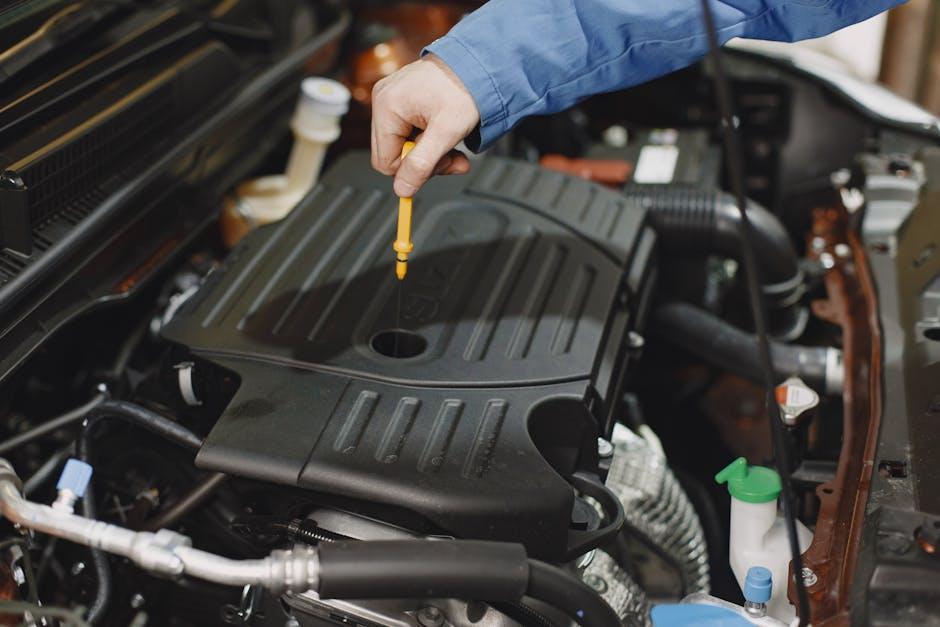Imagine your car as a living machine, each part humming together in a delicate dance of mechanics and motion. Among these components, the oil is like the lifeblood, silently ensuring everything flows smoothly beneath the hood. Yet, despite its crucial role, checking your oil often feels like a chore that’s easy to overlook—or worse, forget altogether. But how often should you really be peeking under the hood? Understanding the rhythm of oil checks can save you from costly repairs and keep your engine purring happily down the road. In this article, we’ll explore the ideal frequency for monitoring your oil levels and why making it a regular habit is one of the smartest moves you can make to protect your vehicle.
Table of Contents
- Frequency Matters for Engine Longevity
- Understanding the Impact of Driving Conditions
- Seasonal Changes and Oil Monitoring
- Signs Your Oil Level Needs Immediate Attention
- Choosing the Right Tools for Accurate Checks
- Incorporating Oil Checks into Your Maintenance Routine
- Q&A
- Final Thoughts

Frequency Matters for Engine Longevity
Maintaining a regular oil check routine is more than a maintenance task; it’s an investment in your engine’s health. Engines rely on consistent lubrication to minimize friction, prevent overheating, and protect internal parts from premature wear. Neglecting oil level checks can lead to degraded performance or, worse, severe engine damage. Ideally, checking the oil should become as habitual as refueling—frequent monitoring helps catch leaks early, identify contamination, and ensure optimal viscosity levels.
Several factors influence how often you should inspect your oil, including driving conditions, vehicle age, and oil type. For some, a weekly glance under the hood is enough; for others, especially those in harsher climates or with older engines, more frequent checks might be necessary. Here’s a quick guide to help determine frequency:
- Urban stop-and-go driving: Check every week or two
- Highway cruising: Check biweekly or monthly
- Older vehicles or models with higher mileage: Weekly checks
- New vehicles under warranty: Follow manufacturer’s recommendations closely
| Driving Condition | Recommended Oil Check Frequency |
|---|---|
| City/Suburban Traffic | Every 1-2 weeks |
| Highway Travel | Every 2-4 weeks |
| Off-road or Heavy Use | Weekly |
| New Vehicles | Manufacturer’s Schedule |

Understanding the Impact of Driving Conditions
Driving conditions play a crucial role in determining how frequently you should check your vehicle’s oil levels. For example, if you often navigate through heavy traffic, endure short, frequent trips, or regularly haul heavy loads, your engine experiences more stress. This heightened demand can cause your oil to degrade faster, making regular checks essential for maintaining optimal engine health and preventing potential damage. Conversely, consistent highway driving at steady speeds usually leads to less oil contamination and evaporation, allowing for longer intervals between checks.
Here’s a quick guide to recognize driving scenarios that might impact your oil check frequency:
- Stop-and-go traffic: Increased engine idling heats up oil faster, reducing its effectiveness.
- Extreme temperatures: Both hot summers and freezing winters can affect oil viscosity and performance.
- Frequent short trips: Prevent oil from reaching optimal operating temperature, leading to faster oil contamination.
- Off-road or dusty conditions: Introduce dirt and debris that can contaminate the oil more quickly.
| Condition | Recommended Oil Check Interval |
|---|---|
| Heavy Traffic / Short Trips | Every 1,000 miles / Monthly |
| Highway Driving | Every 3,000 – 5,000 miles |
| Extreme Weather | Every 1,500 miles / Bi-monthly |
| Off-road / Dusty Areas | Every 1,000 miles / Monthly |

Seasonal Changes and Oil Monitoring
With the arrival of different seasons, your engine oil experiences varying degrees of stress and performance demands. Colder months can cause oil to thicken, making it harder for your engine to circulate lubricant efficiently, while hot summer temperatures can accelerate oil breakdown, reducing its protective qualities. To maintain optimal engine health throughout the year, regular oil checks become more crucial during these transitional periods.
To help you stay on top of oil maintenance, consider these seasonal reminders:
- Winter: Check oil levels more frequently as cold can increase oil viscosity.
- Spring: Monitor for signs of oil contamination after winter road treatments or moisture buildup.
- Summer: Inspect oil condition regularly due to high engine temperatures accelerating oxidation.
- Autumn: Prepare for colder months by ensuring oil quality and topping up if necessary.
| Season | Oil Check Frequency | Key Focus |
|---|---|---|
| Winter | Every 1,500 miles | Viscosity & Thickening |
| Spring | Every 2,000 miles | Contamination & Moisture |
| Summer | Every 1,000 miles | Oxidation & Heat Stress |
| Autumn | Every 2,000 miles | Preparation for Cold |

Signs Your Oil Level Needs Immediate Attention
Recognizing when your engine oil is low or compromised can save you from costly repairs. Keep an eye out for unusual engine noises like knocking or tapping, which often indicate that the oil isn’t lubricating parts properly. Additionally, if your dashboard’s oil pressure light flickers or stays on, it’s a clear warning sign demanding immediate attention. You may also notice a burnt smell, excessive exhaust smoke, or even the engine overheating—these are all red flags suggesting your oil levels or quality have deteriorated significantly.
For a quick reference, here’s a simple guide to common symptoms and their implications:
| Symptom | What It Means | Immediate Action |
|---|---|---|
| Oil Pressure Warning Light | Low oil pressure | Check oil level & top up |
| Knocking Sounds | Insufficient lubrication | Inspect oil quality |
| Excessive Exhaust Smoke | Oil burning or contamination | Service oil system |
| Burning Oil Smell | Leaking or old oil | Inspect & replace oil |
| Engine Overheating | Oil not cooling engine | Check oil level immediately |

Choosing the Right Tools for Accurate Checks
Selecting the ideal instruments for measuring your oil levels can significantly enhance accuracy and ease during maintenance. A quality dipstick, often supplied by the vehicle manufacturer, is the most reliable tool to ensure precise readings. However, innovation has introduced digital oil gauges and smart sensors designed to give real-time insights directly on your dashboard or smartphone app. These modern aids minimize human error and offer detailed diagnostics beyond simple level checks, such as temperature and viscosity metrics.
When choosing your oil checking tools, consider portability, ease of use, and compatibility with your vehicle. Here’s a quick overview of popular options:
- Traditional Dipstick: Simple, no power needed, highly reliable.
- Digital Oil Gauge: More convenient, immediate digital readings.
- Smart Sensors: High-tech option, monitors oil condition continuously.
| Tool Type | Accuracy | Ease of Use | Cost |
|---|---|---|---|
| Traditional Dipstick | High | Moderate | Low |
| Digital Oil Gauge | Moderate | High | Medium |
| Smart Sensors | Very High | Very High | High |

Incorporating Oil Checks into Your Maintenance Routine
Integrating oil level inspections into your regular vehicle care routine doesn’t have to be complicated. By setting a consistent schedule—such as every two weeks or before long trips—you can catch potential issues early, preserving engine health and improving overall performance. Keep an easy-to-reach checklist in your glove compartment or use smartphone reminders to stay on track without fuss.
Consider these simple habits to make oil checks a seamless part of your maintenance:
- Check when the engine is cold: This ensures an accurate reading without oil dispersion.
- Park on level ground: For a true level measurement, avoid sloped areas.
- Use the right dipstick approach: Wipe, reinsert, then remove to check the oil level precisely.
- Document readings: A quick note of the oil status helps track changes over time.
| Maintenance Interval | Recommended Oil Check Frequency | Why It Matters |
|---|---|---|
| Daily Commuters | Weekly | Heavy use demands regular monitoring |
| Occasional Drivers | Biweekly | Prevents unnoticed leaks or degradation |
| Long-Distance Travelers | Before every trip | Ensures smooth engine operation on the road |
Q&A
Q: How often should I check my oil levels?
A: It’s best to check your oil at least once a month. Regular checks help ensure your engine runs smoothly and prevents costly damage.
Q: Does the type of car affect how often I should check the oil?
A: Yes. Older vehicles or those with higher mileage might need more frequent checks, while some newer models with advanced sensors can alert you when oil levels are low.
Q: Should I always check the oil when the engine is cold?
A: For the most accurate reading, check the oil when the engine is cool and the car is on level ground. However, if the car has been running, wait a few minutes after turning it off to allow the oil to settle.
Q: What’s the risk of not checking the oil often enough?
A: Low or dirty oil can cause your engine to overheat or suffer from friction damage, ultimately leading to expensive repairs or even engine failure.
Q: Can driving conditions affect how frequently I should check the oil?
A: Absolutely. Harsh conditions like extreme heat, frequent short trips, or towing heavy loads can cause oil to degrade faster, so more frequent checks are advisable.
Q: What if I’m always on the go and can’t remember monthly checks?
A: Consider setting a recurring reminder on your phone or combining oil checks with other routine car maintenance tasks like tire pressure checks.
Q: Is checking the oil level different from changing the oil?
A: Yes. Checking oil level simply ensures you have enough oil, while changing the oil involves replacing old oil to maintain engine health. Both are crucial, but checking is much more frequent.
Q: What should I do if I find the oil level is low?
A: Top it up with the correct type of oil specified in your owner’s manual and look out for leaks or signs of engine trouble. If unsure, consult a mechanic.
Q: Can neglecting oil checks void my car warranty?
A: It can. Most warranties require regular maintenance including oil monitoring, so staying on top of checks helps keep your warranty valid.
Q: How does regularly checking oil levels save me money?
A: Early detection of low or dirty oil prevents engine damage, improves fuel efficiency, and extends the lifespan of your car—saving you from costly repairs down the road.
Final Thoughts
In the grand scheme of vehicle care, checking your oil levels might seem like a small task, but it’s a vital ritual that keeps your engine humming smoothly. Whether you’re cruising down highways or parked in the driveway, a quick dipstick check can prevent costly repairs and extend your car’s life. So, make it a part of your routine—your engine will thank you with miles of reliable performance. After all, when it comes to oil, a little attention goes a long way.

